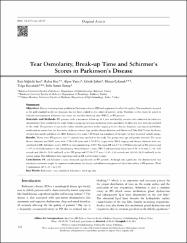Tear osmolarity, break-up time and schirmer's scores in parkinson's disease

View/
Access
info:eu-repo/semantics/openAccessDate
2015Author
Sarı, Esin SöğütlüKoç, Rabia
Yazıcı, Alper
Şahin, Gözde
Ermiş, Sıtkı Samet
Çakmak, Harun
Kocatürk, Tolga
Metadata
Show full item recordAbstract
Objectives: Dry eye is an important problem in Parkinson's disease (PD) with a potential to affect life quality. Tear osmolarity, accepted as the gold standard in dry eye diagnosis, has not been studied in this subset of patients so far. Therefore, in this study we aimed to evaluate tear osmolarity, Schirmer's test scores and tear film break-up time (TBUT) in PD patients.
Materials and Methods: PD patients with a minimum follow-up of 1 year and healthy controls who admitted for refractive abnormalities were enrolled to the study. Subjects using any systemic medication with a possibility to affect tear tests were not included in the study. The presence of any ocular surface disorder, previous ocular surgery, previous dry eye diagnosis, any topical ophthalmic medication or contact lens use were other exclusion criteria. Age, gender, disease duration, and Hoehn and Yahr (H&Y) score for disease severity were noted, and blink rate (BR), Schirmer's test score, TBUT and tear osmolarity of the right eye were measured in both groups.
Results: Thirty-seven PD patients and 37 controls were enrolled to the study. The groups were age and gender matched. The mean disease duration and H&Y score were 5.70 +/- 2.64 years and 1.70 +/- 0.93, respectively. H&Y staging and disease duration were not correlated to BR, Schirmer's scores, TBUT, or tear osmolarity (p>0.05). The mean BR was 8.54 +/- 4.99 blinks/minute in PD patients and 11.97 +/- 46.36 blinks/minute in the control group. Mean Schirmer's scores, TBUT and osmolarity values were 9.08 +/- 4.46 mm, 11.38 +/- 4.05 seconds and 306.43 +/- 12.63 mOsm/L in the PD group and 17.16 +/- 9.57 mm, 12.81 +/- 3.66 seconds and 303.81 +/- 16.13 mOsm/L in the control group. The differences were significant only in BR and Schirmer's scores.
Conclusion: BR and Schirmer's scores decreased significantly in PD patients. Although not significant, the demonstrated tear osmolarity increment might be important to document the dry eye and inflammatory process of the ocular surface in PD patients. Amaç: Kuru göz, Parkinson hastalığında hayat kalitesini etkileme ihtimali bulunan önemli bir problemdir. Kuru göz hastalığının tanısında altın standart olarak kabul edilen gözyaşı ozmolaritesi bu hastalık grubunda bu zamana kadar çalışılmamıştır. Bu nedenle Parkinson hastalarında gözyaşı ozmolaritesinin Schirmer testi ve gözyaşı kırılma zamanı (GKZ) ile beraber değerlendirilmesi amaçlanmıştır.Gereç ve Yöntem: Asgari 1 sene takipli Parkinson hastaları hastaları ve refraksiyon muayenesine başvurmuş, sağlıklı kontroller çalışmaya dahil edildi. Gözyaşı testlerini etkileme ihtimali bulunan sistemik ilaç kullananlar çalışmaya dahil edilmedi. Herhangi bir oküler yüzey hastalığı, geçirilmiş oküler cerrahi öyküsü, kuru göz tanısı, topikal oftalmik ilaç veya kontak lens kullanımı da diğer dışlama kriterleriydi. Yaş, cinsiyet, hastalık yaşı, Hoehn-Yahr (H&Y) skoru kaydedildi ve her iki grupta da sağ gözde göz kırpma sıklığı (GS), Schirmer testi, GKZ ve gözyaşı ozmolarite ölçümleri yapıldı. Bulgular: Otuz yedi Parkinson hastası ve 37 kontrol çalışmaya dahil edildi. Gruplar yaş ve cinsiyet uyumluydu. Ortalama hastalık yaşı ve H&Y skoru sırasıyla 5,70±2,64 yıl and 1,70±0,93 idi. H&Y evresi and hastalık yaşı, GS, Schirmer testi, GKZ ve gözyaşı ozmolaritesi ile korele değildi. Ortalama GS Parkinson hastalarında 8,54±4,99 ve kontrol grubunda 11,97±6,36 idi. Schirmer testi, GKZ ve ozmolarite skorları Parkinson hastalarında sırasıyla 9,08±4,46 mm, 11,38±4,05 saniye and 306,43±12,63 mOsm/L ve kontrol grubunda 17,16±9,57 mm, 12,81±3,66 saniye and 303,81±16,13 mOsm/L idi. Anlamlı farklılık sadece GS ve Schirmer skorlarında mevcuttu.Sonuç: GS ve Schirmer skorları Parkinson hastalarında anlamlı olarak azalmıştı. İstatistiksel olarak anlamlı olmasa da, Parkinson hastalarında yüksek bulunan gözyaşı ozmolaritesi göz yüzeyinde kuru göz ve enflamasyon sürecini göstermesi açısından önemli olabilir.

















